The last Premier League match of the decade at the Molineux Stadium saw Wolverhampton Wanderers take on Manchester City, their first of two matches within 48 hours. The hosts stunned Manchester City earlier this season at the Etihad Stadium, scoring two late goals, and obtaining the three points. They made it a bit more difficult for themselves this time, going two goals down, despite having an extra man on the pitch. However, Wolves were able to turn it around, and the dramatic end to the match saw them win 3-2.
This tactical analysis will how Manchester City were able to cope despite going down a man early, how Wolves were struggling to initially break down Manchester City, and how the tables turned late on in the second half.
Lineups
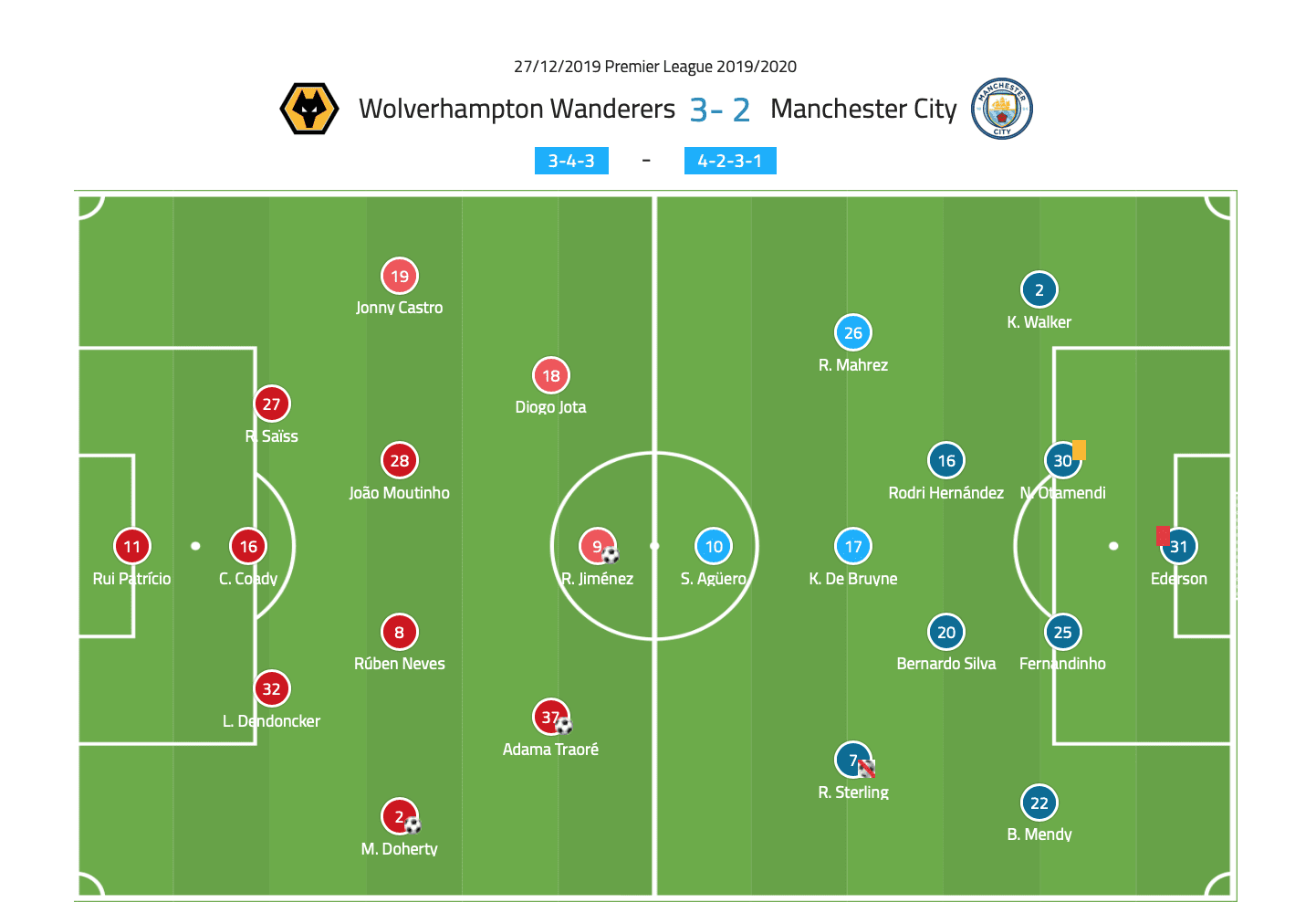
Nuno Espírito Santo set up his side in their usual 3-4-3, his most used formation. In front of Rui Patrício stood a back three, which consisted of Leander Dendoncker, Conor Coady, and Romain Saïss. Rúben Neves and João Moutinho were lined up in central, with Matt Doherty and Jonny Castro covering the flanks. A front three of Adama Traoré, Raúl Jiménez, and Diogo Jota lead the line.
Pep Guardiola opted for a formation change for his trip to the Molineux, opting for a 4-2-3-1 rather than his usual 4-3-3. The back four consisted of Kyle Walker, Nicolás Otamendi, Fernandinho, and Benjamin Mendy, who were situated in front of Ederson in goal. Rodri and Bernardo Silva were in central midfield, with Kevin De Bruyne slightly ahead of them. City’s front three consisted of Riyad Mahrez, Sergio Agüero, and Raheem Sterling.
How Wolves forced Manchester City down to 10
Twelve minutes in, Ederson was sent off for denial of an obvious goal-scoring opportunity. What is important to note, though, is how Wolves were able to get Ederson in such a vulnerable position that he had to resort to the foul, and the fact that this was a tactic that Wolves were looking to use throughout the match.
The tactic was the long ball over the top of Manchester City’s defence, using the pace of Wolves’ frontline, specifically Traoré’s to get in behind the defence. Manchester City’s defence has been quite disjointed for some time now because the injury of Aymeric Laporte has forced Guardiola to play Fernandinho as a centre-back. This is turn has forced new signing Rodri to not have the luxury of taking the time to adapt to a new league, a new system, and new teammates.
Wolves first tested the long-ball tactic over the defensive line within the first six minutes of the match. Unfortunately for them, Coady’s pass was just a bit too short for Traoré, and Fernandinho was able to head it away. If the pass had just a bit more power on it, Traoré would have easily beat both Fernandinho and Mendy to it, and he would have found himself 1vs1 with Ederson, as Otamendi was not in a proper position to provide support.
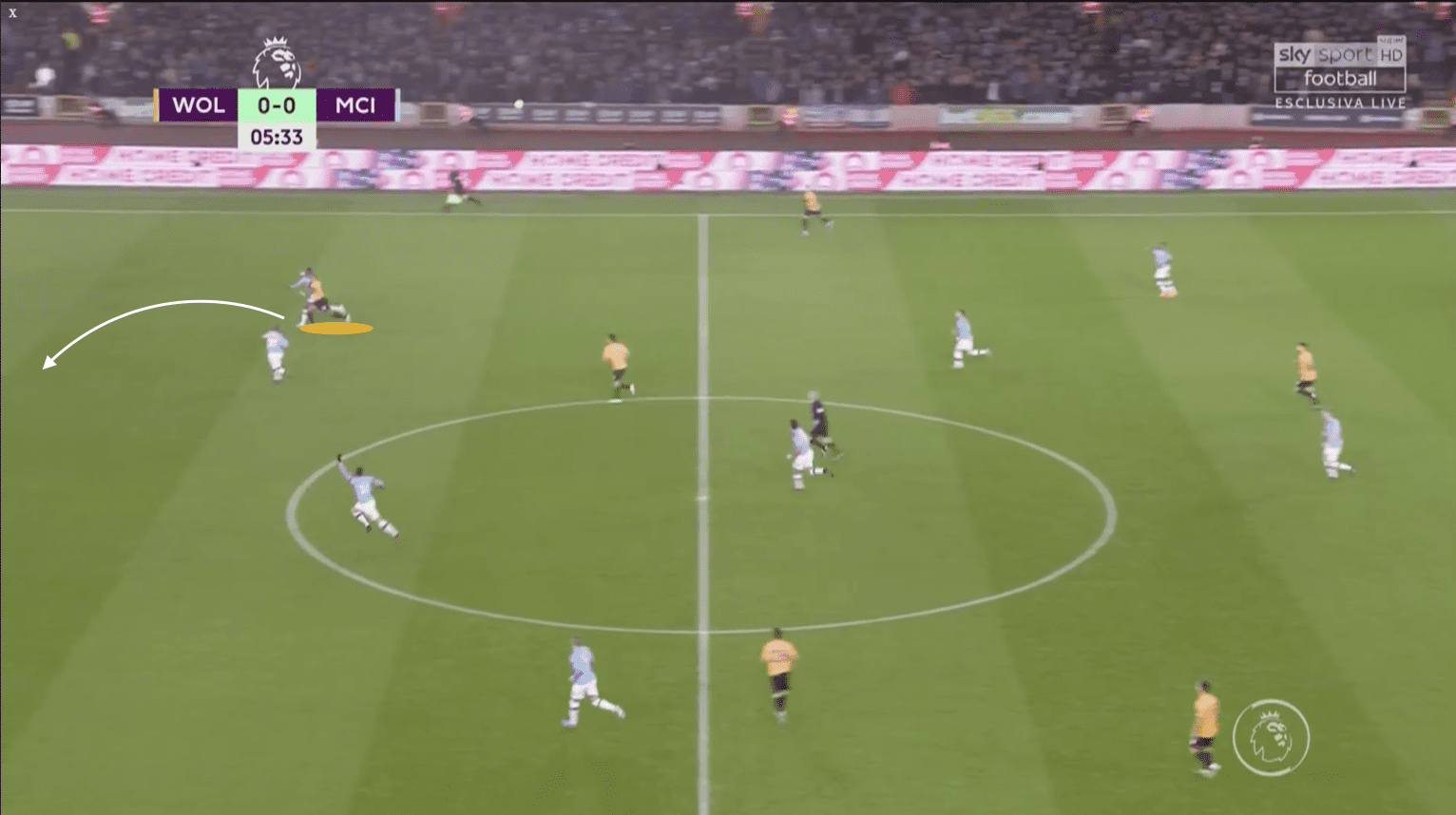
Wolves’ next long ball was a few minutes later, and this time Coady’s pass was perfect for Diogo Jota. He quickly sped past Otamendi and received the ball in the ample space that was behind Manchester City’s high line. This created a 1vs1 situation vs Ederson, and the Brazilian keeper was forced to foul Diogo Jota, leading to his sending off.
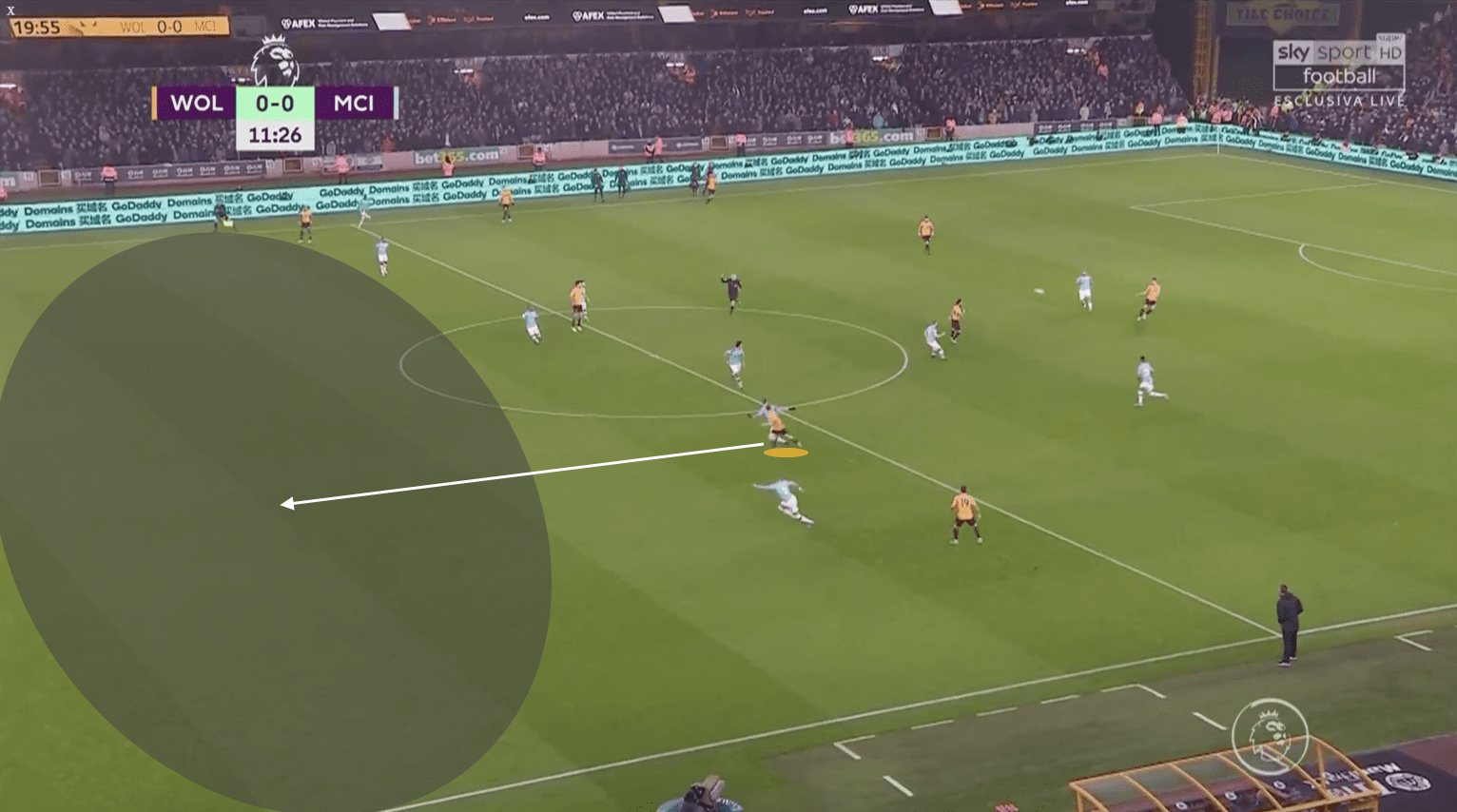
Throughout the match Wolves continuously attempted this long-ball tactic, with 45 attempts, compared to Manchester City’s 25. Manchester City were clearly struggling with intercepting them and clearing them as well, with 71% of Wolves’ long balls being accurate when they usually average an accuracy of about 58%.
Obviously, Nuno had no idea his tactic would end in a Manchester City red card, but the tactic certainly helped in securing their win, as it exposed one of Manchester City’s weaknesses in defence. Furthermore, the fact that they attempted so many long balls, forcing the line to have to run back over and over again was tiring, and fatigue played a massive role in Wolves being able to complete their comeback late, against tired legs.
Guardiola’s response
It is always difficult to go down to 10 men, especially so early in a match. However, Manchester City initially coped well and managed to score two goals and keep a clean sheet for over 50 minutes.
After Ederson was sent off, Agüero was subbed off, and Manchester City to a 4-4-1; the two banks of four stretching the pitch, ensuring the coverage of the flanks, and Sterling up top, who has experience playing as a #9.
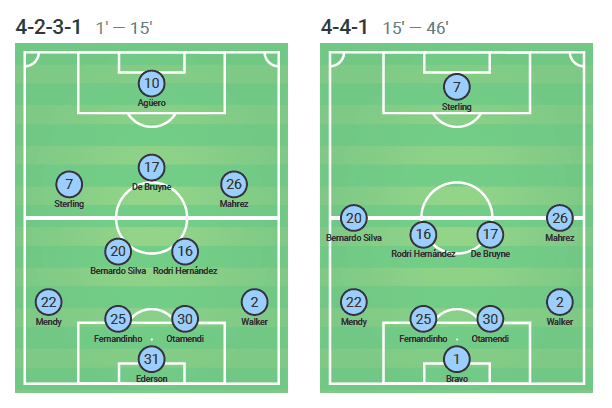
The 4-4-1 worked out of possession mainly because it saw De Bruyne and Rodri essentially man-mark Moutinho and Neves. Both players in central midfield are often used by Wolves to recycle possession and penetrate the opposition’s backline through the middle.
Prior to Ederson’s sending off, Manchester City were pressing from the front, leading to that highline, and the space in behind that Wolves could exploit. In the 4-4-1 though, they sat back much deeper and were much more compact in their half. This meant that Wolves needed to rely on their central midfielders to dictate play. However, De Bruyne and Rodri did such a good job of isolating them and forcing them to recycle meaningless possession backwards, both players, specifically Neves really struggled to create anything in the first half.
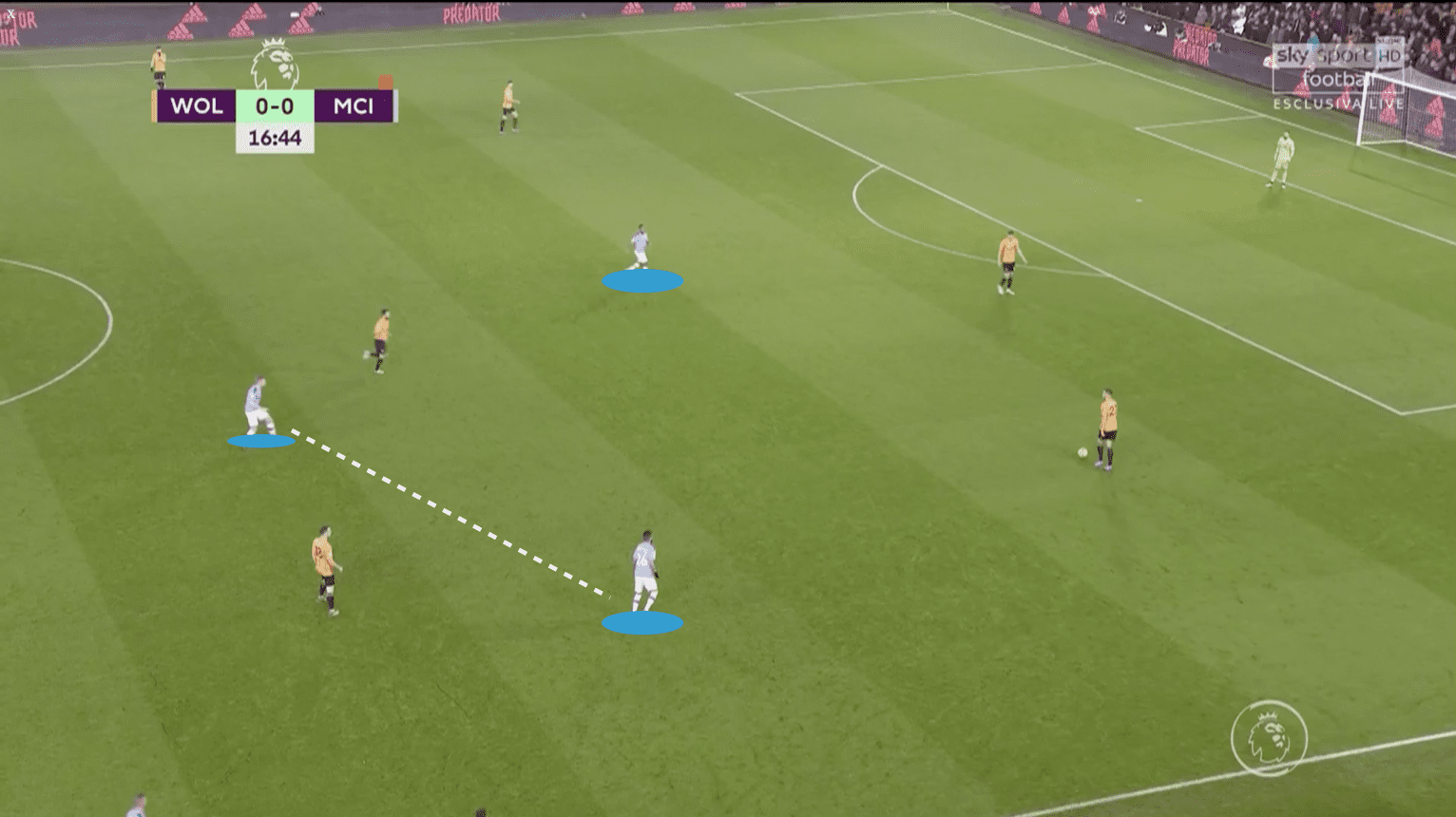
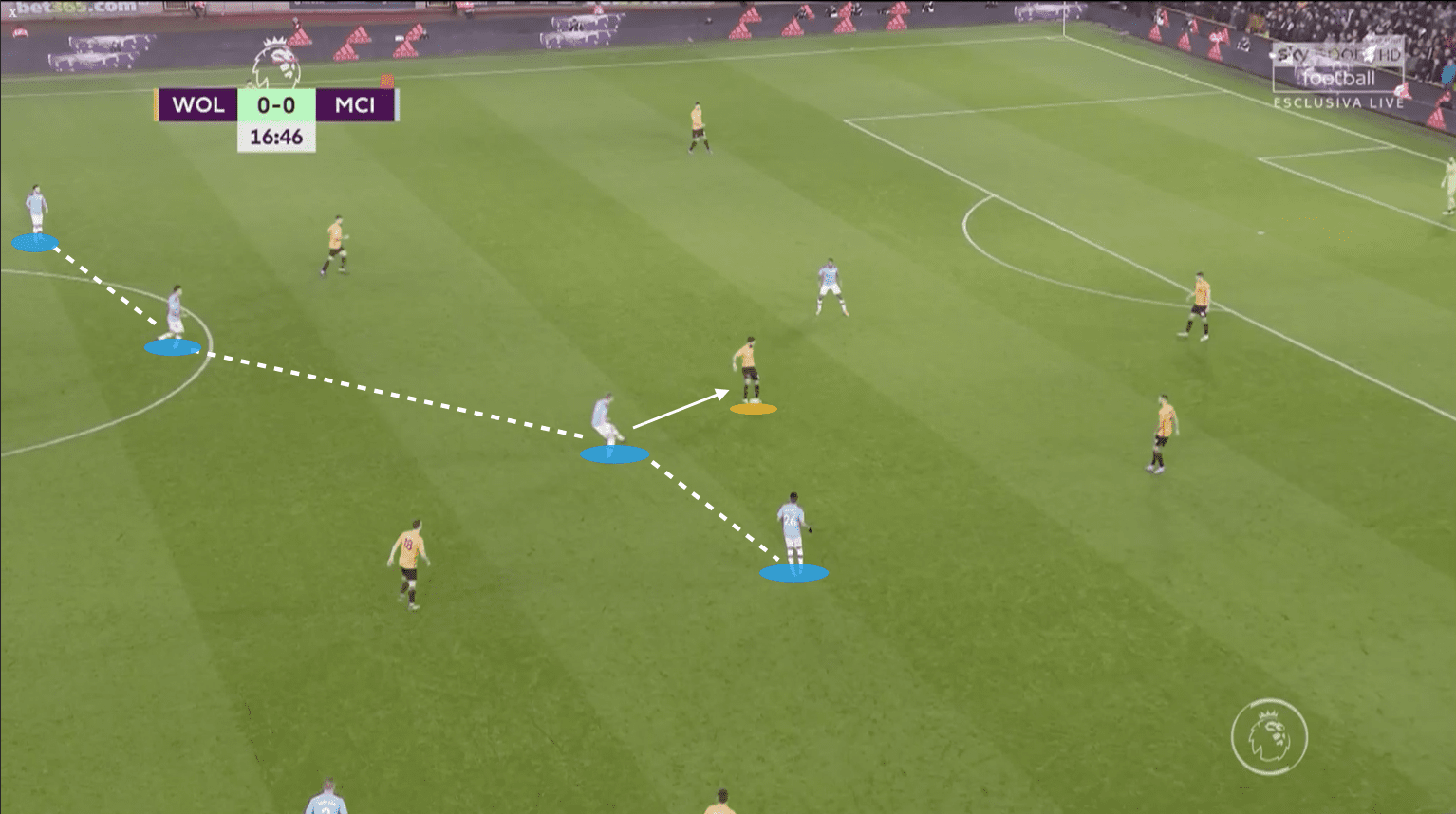
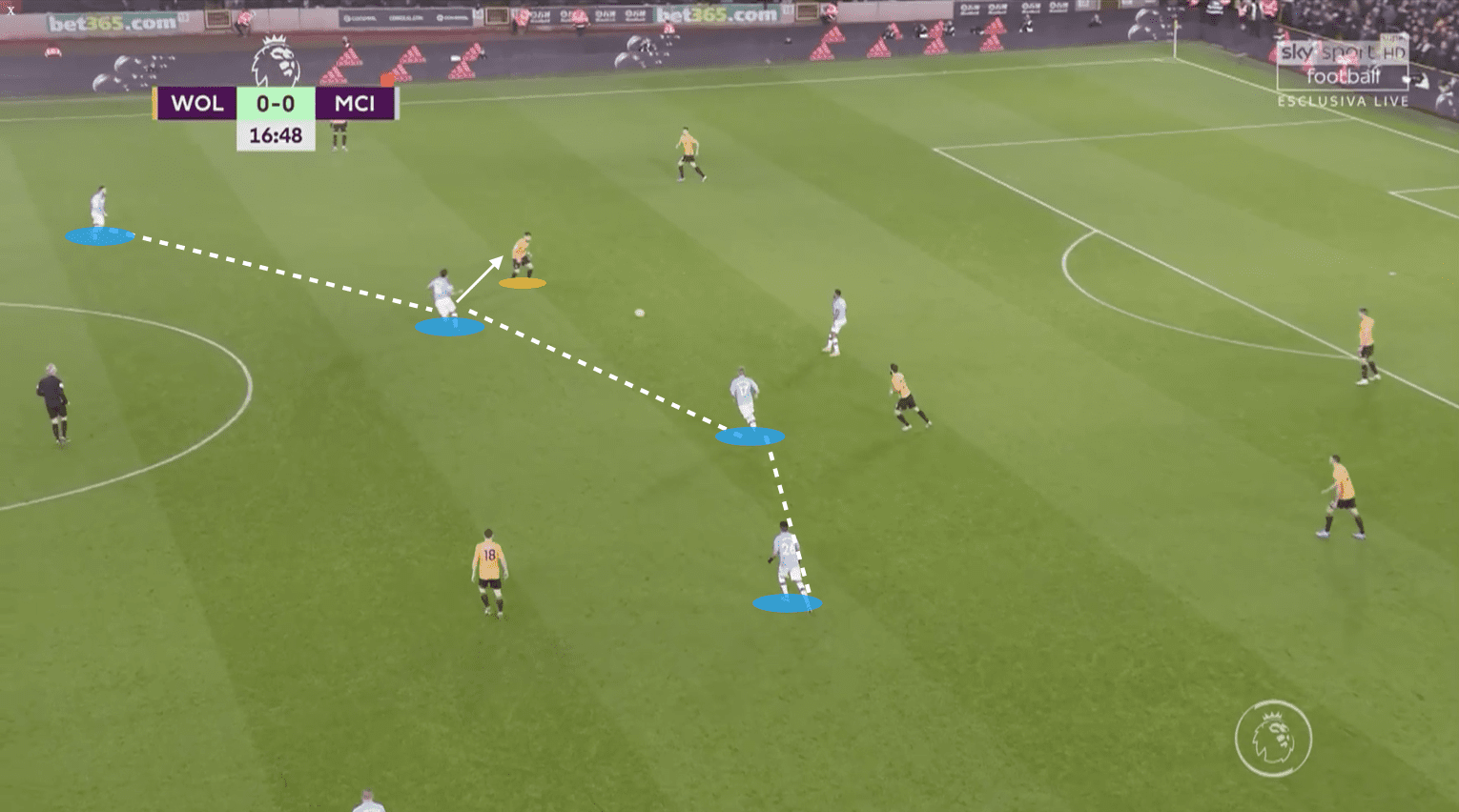
Because the two in midfield struggled to create, this led to Wolves’ front line to drop in deep and collect the ball. When the three front players would drop deep, it would lead to a congested middle that made it easy for Manchester City to defend. The 4-4-1 saw Wolves really struggle to create any big chances in the match, despite having a numerical advantage on the pitch, and there was no tactical change from Nuno to try and change his side’s fortunes. On the other hand, Manchester City recovered well despite going down a man so early.
Guardiola undoes his tactical work
Just after half time, Manchester City scored their second, and while it would be unfair to say they had control of the match, they seemed quite calm, understandably. This is when Guardiola made another tactical change that very much hurt his side, rather than aided it, and allowed Wolves to score three goals.
The 46th minute saw Guardiola switch from the 4-4-1 to a 5-3-1, bringing on defender Eric García for attacker Mahrez. He then later made another defensive substitution, bringing on İlkay Gündoğan for De Bruyne.
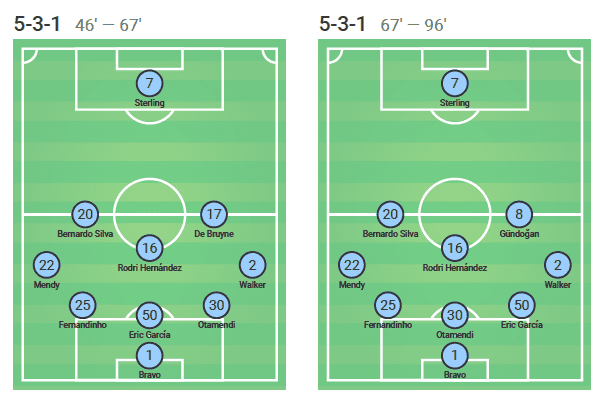
Furthermore, post-half-time, a much more aggressive Wolves side came out, as they became much more energetic in their pressing, and shifted higher up the pitch as a unit. The roles almost switched from what is usually expected from a team playing against a Manchester City side; with Wolves having the highline, and Manchester City sitting deep, attempting to protect their lead.
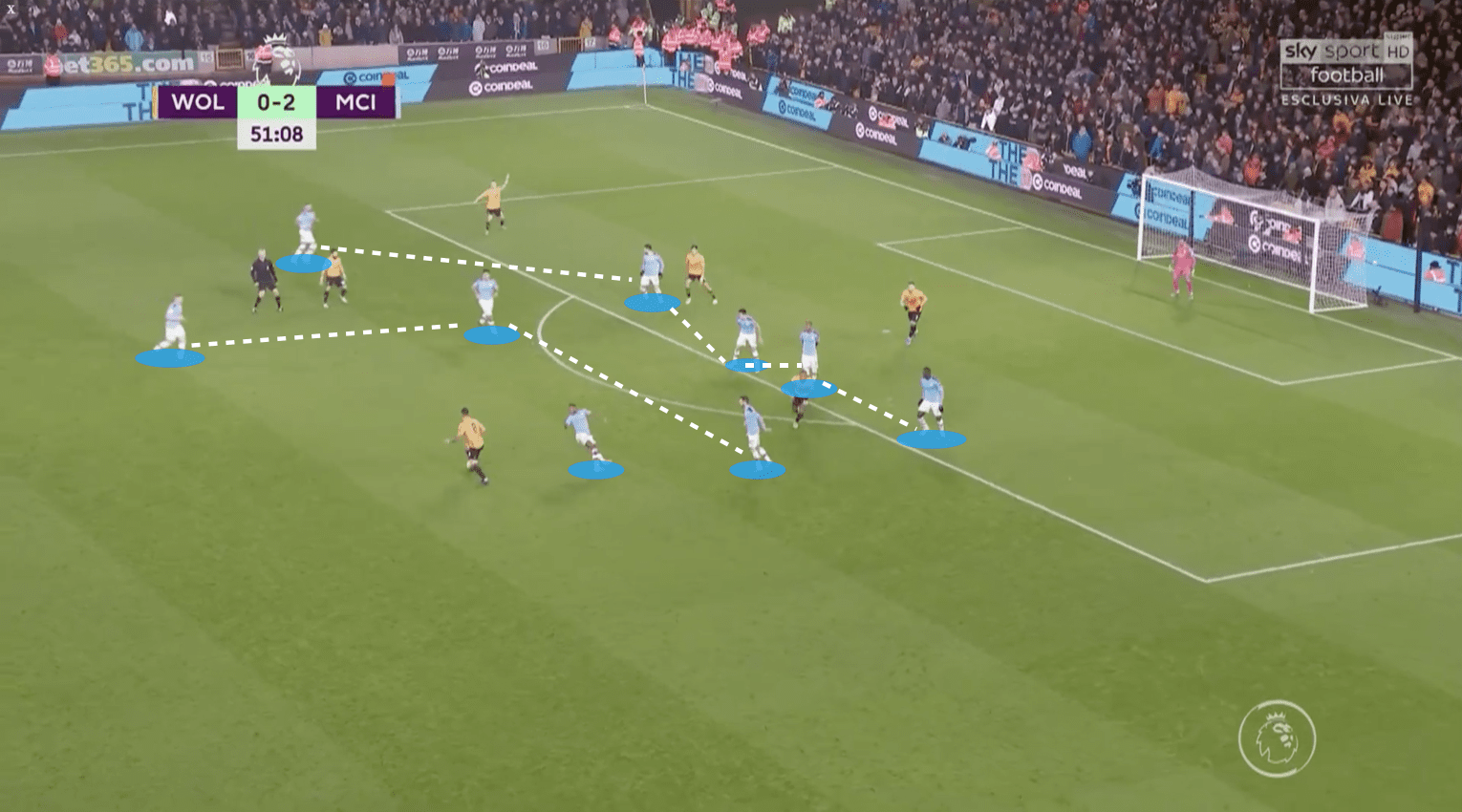
At first, the 5-3-1 seemed like a good shift, as Wolves were still unable to isolate Manchester City players into dangerous areas and work the ball into the net. In fact, Manchester City’s second came from this formation, starting from Rodri, who was playing deep, and ending with Sterling chipping the ball over Patrício.
However, after that goal, Manchester City kept on getting pushed deeper, were not able to hold on to possession for long periods of time, and were not having luck in getting the ball forward to Sterling. Too many individual mistakes too close to their net was the reason for their loss, as well as the fatigue of constantly being in defensive mode. As deep as they were, they became less compact, and different players struggled to keep on their man. This was seen in Traoré’s first goal with Sterling making a mistake, Bernardo failing to cover Traoré and Mendy being caught out of position, and unable to provide support.
When De Bruyne was substituted, making way for Gündoğan, the rationale was most likely that De Bruyne would need rest for the Sheffield United game, and that he was compromising the shape of the midfield three, and often drifting further forward, to support Sterling. This substitution was costly though, as without De Bruyne’s attacking runs, Wolves had less fear of Manchester City scoring a third, and their three centre-backs were able to push even higher up. The final ten minutes saw an abundant of mistakes made from Manchester City’s defensive side, and against the fresh legs of Pedro Neto and Ruben Vinagre, they were forced to suffer wave, after wave of attack. Wolves’ second goal starts with Saïss, who moves up because De Bruyne is not on the pitch anymore, and is scored because of mistakes from Walker and Mendy. Their third comes from mistakes Mendy, and Otamendi.
Manchester City’s tactics showcased that they dealt well with going down a man so early, but Guardiola going uber defensive in the second half, along with the abundance of mistakes from his players allowed Nuno’s side to take home the three points, and ultimately do the double over Manchester City this season. This analysis shows that while Nuno never made any major tactical changes, their aggressiveness in the second half to pin their opponents back won them the match.
A shift in goals for the season?
Earlier this season, it was looking quite dire for Wolves. They were in 19th place in the table, just above Watford, and they seemed to be struggling with the Europa League fixture congestion. Many touted them to not have as strong a league season as they did last year and therefore thought it was wise for them to focus on cup competitions and the Europa League. Now, however, they sit seventh in the table, and they are equal with Tottenham points-wise, the latter only in sixth due to goal difference. Their league season started slow, but now, they are in a position where they can fight for a top-six spot, specifically because teams like Chelsea, Manchester United, and Tottenham have all shown great inconsistency. Nuno needs to find the right balance between competitions, and ensure he rotates his team properly in order to be consistently strong in the league, Europa, as well as the FA Cup.
Unless a major collapse to league leaders, Liverpool, occurs it looks unlikely that Manchester City will do a threepeat of winning the league. They are still in a strong position to finish top four, and the goal should be to try and pip Leicester City to second place. Then, Guardiola must turn his attention to the Champions League, the one trophy the club have not been able to get their hands on. Their round of 16 draw against Real Madrid will be tough, but they will need to get through it, as well of the next rounds in order to at least reach the Champions League final. Failure to do so, along with failure to win the league would be considered an awful season for Manchester City.

If you love tactical analysis, then you’ll love the digital magazines from totalfootballanalysis.com – a guaranteed 100+ pages of pure tactical analysis covering topics from the Premier League, Serie A, La Liga, Bundesliga and many, many more. Buy your copy of the December issue for just ₤4.99 here





Comments